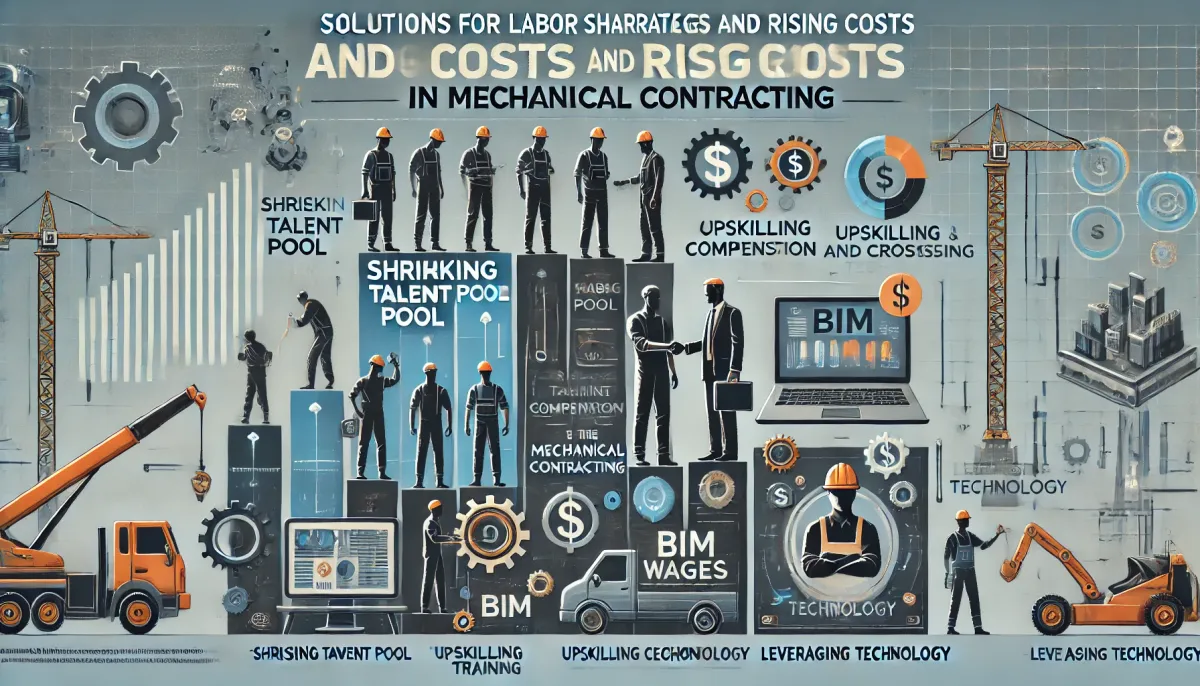
The mechanical contracting industry plays a critical role in infrastructure development, handling complex systems such as HVAC, plumbing, and refrigeration. However, one of the most pressing challenges it faces today is the shortage of skilled labor, which directly impacts project timelines and budgets. Coupled with rising labor costs, this issue has become a significant hurdle for contractors striving to deliver projects efficiently.
A Shrinking Talent Pool
Mechanical contractors rely on highly specialized tradespeople, such as welders, pipefitters, and HVAC technicians, to execute their projects. Unfortunately, the pool of qualified candidates has been steadily shrinking. A combination of factors, including an aging workforce, fewer young people entering skilled trades, and increased competition from other industries, has exacerbated this problem.
As demand outpaces supply, wages for skilled laborers have surged. According to Reuters, wages in key trades have risen by as much as 20% since 2021. While these increases are necessary to attract and retain talent, they put additional strain on project budgets and often force contractors to delay projects due to staffing shortages.
The Ripple Effect on Projects
Labor shortages and rising costs create a domino effect across the industry. Contractors face difficulties meeting deadlines, which can lead to financial penalties and strained client relationships. Additionally, the lack of available workers forces companies to either overburden existing staff or subcontract work, both of which can compromise quality and efficiency.
For example, delayed timelines not only increase overhead costs but also jeopardize contractors’ ability to bid on new projects. These challenges are particularly pronounced in large-scale or highly technical projects, where even minor delays can have cascading effects.
Proactive Solutions: Building the Workforce of the Future
To combat labor shortages, many mechanical contractors are adopting proactive strategies aimed at workforce development and talent retention. Some of the most effective measures include:
- Apprenticeship and Training Programs
Contractors are partnering with trade schools and vocational programs to cultivate the next generation of skilled workers. Apprenticeships provide hands-on training while allowing companies to groom employees who align with their operational needs and values. - Competitive Compensation and Benefits
Offering higher wages, signing bonuses, and comprehensive benefits packages helps attract skilled professionals in a competitive job market. Contractors are also focusing on creating supportive work environments to boost employee satisfaction and reduce turnover. - Upskilling and Cross-Training
Companies are investing in upskilling programs to enhance the capabilities of their existing workforce. Cross-training workers in multiple trades increases operational flexibility and reduces dependency on external hires. - Leveraging Technology for Efficiency
While labor shortages persist, many contractors are turning to technology to offset workforce limitations. Tools like automation and Building Information Modeling (BIM) help streamline processes and improve productivity, allowing smaller teams to accomplish more.
Industry-Wide Collaboration
Addressing labor shortages requires collaboration beyond individual contractors. Industry associations and trade organizations play a pivotal role in advocating for policy changes, promoting the trades as a viable career option, and providing resources for workforce development. Governments and private entities can also contribute by offering incentives for training programs and apprenticeships.
The Path Forward
While labor shortages and rising costs present significant challenges, they also provide an opportunity for the mechanical contracting industry to innovate and evolve. By investing in workforce development, embracing technology, and fostering a culture of collaboration, contractors can build a resilient and sustainable workforce for the future.
The road ahead will require strategic planning and collective effort, but with the right initiatives, mechanical contractors can overcome these challenges and continue to thrive in a dynamic industry.
Let’s Keep Talking:
Jenny is a business insurance broker with Waypoint Insurance.
She is also a business development consultant with Impresario Partners, helping Canadian Business expand overseas.
She can be reached at 604-317-6755 or jhansen@waypoint.ca. Connect with Jenny on LinkedIn at https://www.linkedin.com/in/jenny-holly-hansen-365b691b/. Connect with Jenny at BlueSky: https://bsky.app/profile/jennyhollyhansen.bsky.social
Let’s Meet Up:
Jenny Holly Hansen is a cohost with Chris Sturges of the Langley Impact Networking Group. You are welcome to join us on Thursday’s from 4pm to 6pm at: Sidebar Bar and Grill: 100b - 20018 83A Avenue, Langley, BC V2Y 3R4
Tags: #Jenny Holly Hansen #Labour Shortages #Rising Costs #Mechanical Contractors #Skilled Labour Shortage


